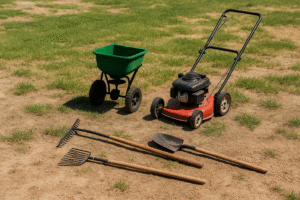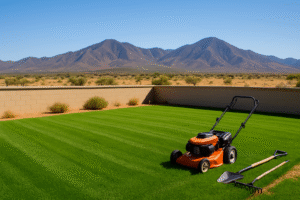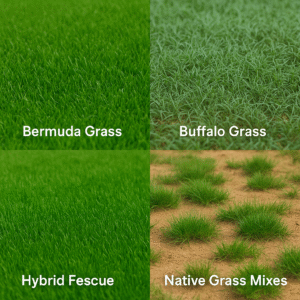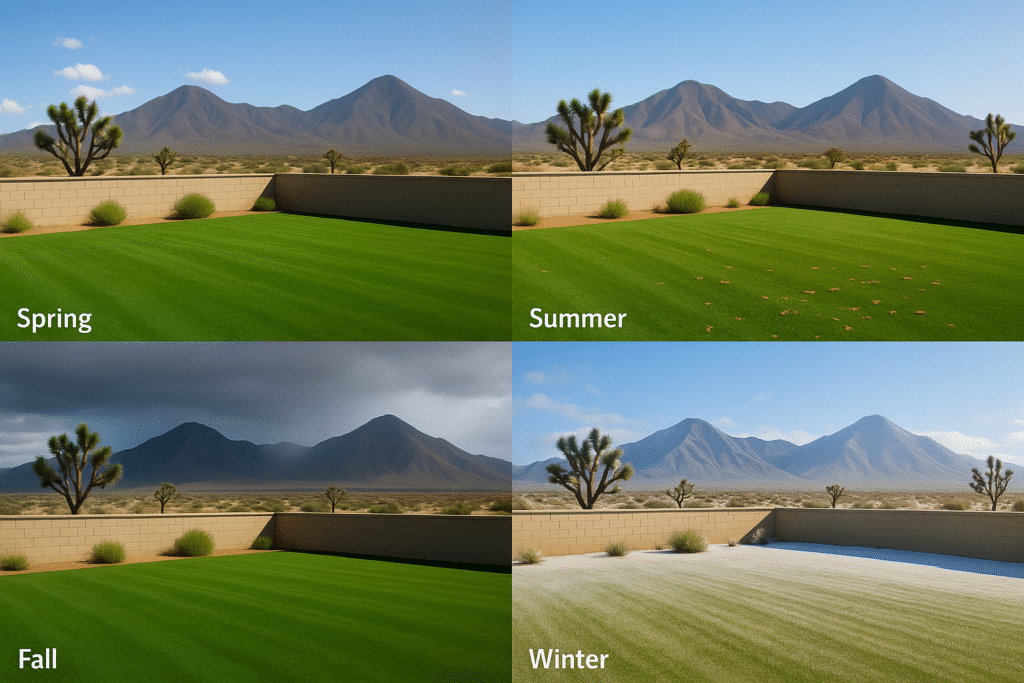The Ultimate Lawn Care for High Desert Yards: A Month-by-Month Guide
Introduction

AV Green Solutions Happy Customer
A beautiful lawn in the Antelope Valley doesn’t happen by accident.
Between intense sun, high winds, and little rain, keeping your yard thriving requires a smart plan and the right techniques.
In this guide, you’ll learn exactly what your lawn needs month-by-month to survive and thrive in our unique high desert climate.
Let’s dive into the ultimate lawn care calendar for desert success.
Spring: Waking Up Your Lawn
Early Spring (March–April)
After the cool, windy winter, spring brings a chance to revive your lawn.
Focus on:
-
Deep raking to remove debris and stimulate new growth.
-
Soil testing to check for pH balance (desert soils often need amendments).
-
Applying pre-emergent herbicides to stop weeds before they sprout.
-
Sharpening your mower blades—clean cuts are vital in dry conditions.
Local Tip:
Focus on drought-tolerant grasses like Bermuda, Buffalo, or a hardy fescue blend.
Mid to Late Spring (April–May)
As temperatures rise, your lawn’s roots need strength.
Focus on:
-
Fertilizing with a balanced, slow-release fertilizer.
-
Overseeding thin areas if needed, especially after a dry winter.
-
Watering early mornings—the desert sun evaporates water fast.
Pro Tip:
Always water deeply, but less frequently. Shallow watering leads to weak roots.
Summer: Surviving the High Desert Heat
Early Summer (June)
Heat intensifies in the AV starting in June.
Focus on:
-
Raising your mower height—longer grass shades roots and conserves moisture.
-
Checking irrigation systems to ensure even coverage.
-
Applying light fertilizer only if needed (preferably organic or low-nitrogen).
Mid to Late Summer (July–August)
Summer brings brutal heat and dry winds.
Focus on:
-
Watering 2–3 times per week before 9 AM.
-
Skipping fertilization unless absolutely necessary.
-
Watching for pests like grubs that thrive in stressed lawns.
Fall: Preparing for a Strong Comeback
Early Fall (September)
Fall is the best time for serious lawn upgrades in the desert.
Focus on:
-
Aerating compacted soil to allow better water penetration.
-
Overseeding with drought-tolerant blends if the summer was hard on your lawn.
-
Applying a slow-release fertilizer heavy in potassium for winter hardiness.
Mid to Late Fall (October–November)
Cooler temperatures mean ideal growing conditions.
Focus on:
-
Continuing to mow and water regularly until growth naturally slows.
-
Applying a winterizer fertilizer before the first frost.
-
Clearing fallen leaves to avoid disease and fungus.
Local Tip:
Use mulch mowing for small leaf drops—it returns organic material back to the soil.
Winter: Protecting Your Investment
Early Winter (December–February)
By winter, most high desert lawns are dormant.
Focus on:
-
Limiting foot traffic—frozen or stressed grass breaks easily.
-
Planning any major lawn renovations for early spring.
-
Maintaining irrigation systems to prevent freeze damage.
Pro Tip:
Desert lawns often need no watering once dormant—check local watering ordinances to save water and money.
How to Fix a Damaged Lawn
Even the best lawns sometimes suffer.

Bare Spots
-
Rake the area gently.
-
Apply fresh topsoil and seed.
-
Water daily until new grass is established.
Thinning Grass
-
Aerate the entire lawn to loosen compacted soil.
-
Overseed with a drought-tolerant blend.
-
Fertilize lightly to encourage recovery.
Yellow or Brown Patches
-
Check irrigation coverage.
-
Treat for pests like grubs if you see damage under the surface.
-
Adjust watering schedule—sometimes brown spots mean too much water, not to
-
o little.
The quicker you address lawn damage, the faster it will recover.

Common Lawn Care Mistakes to Avoid
Even experienced homeowners sometimes hurt their lawns without realizing it.
Mistakes to watch for:
-
Overwatering—creates shallow roots and disease.
-
Mowing too short—exposes roots and dries out the soil faster.
-
Ignoring soil health—pH balance is critical in desert environments.
-
Wrong grass choice—cool-season grasses often fail in the AV’s extreme summers.
-
Heavy summer fertilizing—burns grass during peak heat.
-
Skipping aeration—results in poor water absorption.
Avoiding these mistakes can make the difference between a struggling lawn and a thriving one.
Essential Lawn Care Tools for High Desert Yards
Must-haves:
-
Core aerator (to help water penetrate hard soil)
-
Mower with adjustable height settings
-
Efficient sprinkler system (preferably drip or low-flow heads)
-
Soil testing kit (to manage desert alkalinity)
-
Heavy-duty rake (windstorms bring lots of debris)
-
Manual or battery-powered spreader
-
Lawn roller for post-seeding work
-
Hand weeder for spot treating
Having the right tools makes maintaining a desert lawn faster and more effective.
Irrigation Best Practices for the High Desert
Keeping your lawn alive during AV summers is all about watering smarter, not just more.
Timing Matters
-
Water early in the morning (before 9 AM).
-
Avoid watering after noon — up to 40% of water evaporates before reaching the roots.
How Often to Water
-
In peak summer: 2 to 3 deep waterings per week.
-
In spring and fall: 1 to 2 deep waterings per week.
Allow the soil to dry between waterings to promote deep root growth.
Drip Systems vs. Sprinklers
-
Sprinklers are good for lawns but should be low-angle or rotary heads to minimize evaporation.
-
Drip systems are ideal for gardens, borders, or drought-tolerant landscaping.
Pro Tip:
Install a smart irrigation controller that adjusts automatically based on weather.
Choosing the Right Grass for Your Antelope Valley Lawn
Picking the right type of grass is half the battle when it comes to lawn success in the desert.
Best Choices for AV:
-
Bermuda Grass – Handles heat well, stays green in summer.
-
Buffalo Grass – Extremely drought-tolerant, low-maintenance.
-
Hybrid Fescue – Great for slightly cooler parts of the valley.
-
Native Grass Mixes – Blend well with desert landscaping.
What to Avoid:
-
Cool-season grasses like Kentucky Bluegrass will struggle without heavy watering.
-
Shade-only grasses tend to burn up in full desert sun.
Choosing the right grass up front saves you time, money, and frustration later.

Creating a Drought-Tolerant Lawn
Want a lawn that looks great and uses less water?
Here’s how:
Select the Right Grass
Choose drought-tolerant varieties like:
-
Bermuda Hybrid
-
Buffalo Grass
-
Zoysia Grass (moderate drought tolerance)
Improve Your Soil
-
Aerate to break up compaction.
-
Mix compost or organic amendments into sandy soil.
Water Deeply, Infrequently
Encourage roots to grow downward where moisture lasts longer.
Consider Blended Landscaping
-
Use lawn for high-traffic/play areas.
-
Replace low-use zones with native desert plants, rocks, and mulch.
Expanded FAQs About High Desert Lawn Care
“When should I reseed my lawn in the desert?”
The best time is early fall (September–October).
Spring reseeding can work, but you’ll need to water heavily before the heat arrives.
“What’s the best way to control pests like grubs or armyworms?”
-
Apply beneficial nematodes or insecticide in early summer.
-
Water properly — stressed lawns attract pests faster.
“How do I prepare my lawn for a heatwave?”
-
Raise your mower height.
-
Water deeply 1–2 days before peak heat.
-
Avoid mowing or fertilizing during extreme heat.
“Is synthetic turf better than natural grass?”
-
It depends.
-
Natural grass is cooler and provides real ecosystem benefits but needs maintenance.
-
Artificial turf saves water but gets very hot in direct sun and requires surface sanitization.
Quarterly Lawn Care Checklist
- Organizing lawn tasks seasonally makes life easier.

Spring (March–May)
-
Rake up winter debris.
-
Soil test and amend if needed.
-
Apply pre-emergent herbicide.
-
Fertilize lightly.
-
Begin watering schedule as temps rise.
Summer (June–August)
-
Mow higher to shade soil.
-
Water deeply 2–3x per week.
-
Spot treat weeds.
-
Monitor for pests.
-
Skip heavy fertilization.
Fall (September–November)
-
Core aerate the lawn.
-
Overseed bare/thin spots.
-
Fertilize for winter root growth.
-
Rake leaves or mulch mow.
Winter (December–February)
-
Limit lawn traffic.
-
Inspect irrigation for leaks or damage.
-
Plan spring lawn upgrades.
-
Enjoy your dormant lawn with minimal upkeep.
How AV Green Solutions Can Help Maintain Your Lawn Year-Round
Lawn care in the Antelope Valley is different than anywhere else — and our local team knows exactly how to get results.
At AV Green Solutions, we offer:
Service Packages
-
Basic Lawn Care: Fertilization, mowing schedule consultation, weed prevention.
-
Deluxe Lawn Renewal: Aeration, overseeding, soil amendment, irrigation tune-up.
-
Smart Watering Upgrade: Drip conversion, smart controller installation, water audits.
-
Desert Landscaping Transition: Partial lawn-to-drought-tolerant plant redesign.
Why Professional Help Matters
-
Save Water: Experts optimize watering to avoid waste.
-
Save Time: No need to guess fertilizer types, seed blends, or pest treatments.
-
Long-Term Results: Healthy lawns last longer with less reseeding or repair costs.
Let AV Green Solutions be your partner in a greener, more sustainable backyard.
Ready to transform your lawn? Contact AV Green Solutions today for a free consultation!
Conclusion: A Lush Desert Lawn Is Within Reach
Even in the harsh conditions of the Antelope Valley, a lush lawn is possible — with smart planning, patience, and the right team by your side.
By following this seasonal calendar, making smart choices about grass type and watering, and taking proactive care, you’ll create a space that stays beautiful year after year.
At AV Green Solutions, we’re proud to help our community bring sustainable beauty to the desert.
Let’s grow something amazing together!